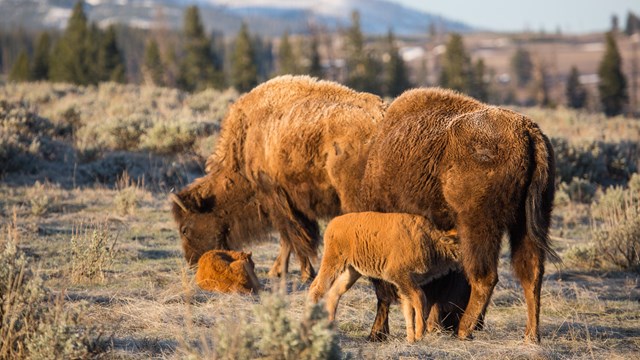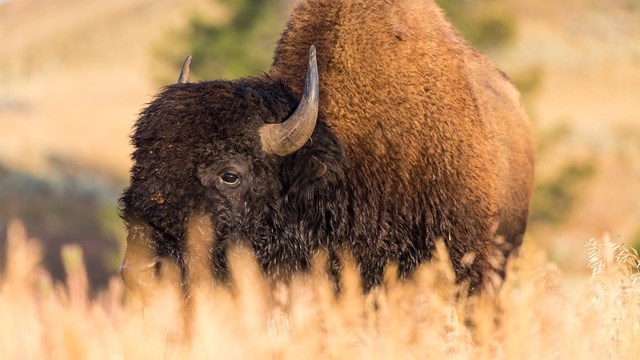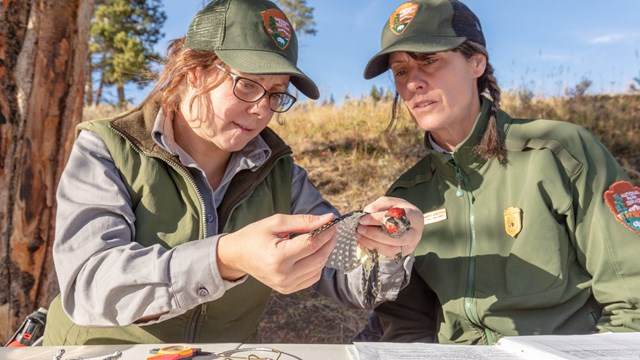|
Visit our keyboard shortcuts docs for details
The protection and recovery of bison in Yellowstone is one of the great triumphs of American conservation. This video explains why Yellowstone bison are managed. The National Park Service (NPS) has sole authority to manage bison within the boundaries of Yellowstone National Park. However, the NPS coordinates with other federal, state, and American Indian Tribes pursuant to an Interagency Bison Management Plan (IBMP) signed in 2000 by the secretaries of Agriculture and Interior and the governor of Montana because bison, like other wildlife, leave the boundary of the park. Bison are managed differently than other wildlife because the state of Montana provides limited tolerance for bison migrating out of the park. Our GoalsWe preserve a sustainable population of 3,500-6,000 wild, migratory bison.Yellowstone’s bison are the closest resemblance left today of the vast herds that once roamed the continent. Bison act as ecosystem engineers fundamentally designing grassland ecosystems, and they hold significant cultural importance to people, with a connection spanning thousands of years. We coordinate with federal, state, and Tribal partners to manage the bison population.Yellowstone bison must be managed because the population is growing exponentially and there is limited winter range for bison within the park. Like other wildlife, bison migrate out of the park to find food in winter, but unlike other wildlife, there is limited tolerance for them outside the park. Yellowstone works with its partners to control numbers, limit bison migrating out of the park, and help Tribes restore Yellowstone bison to their livelihoods. We develop the best available science to preserve our national mammal.Making decisions about bison population management requires contemporary research on population viability, habitat use, and the effects that bison have on grasslands to ensure a sustainable bison population and habitat. Conserving Yellowstone BisonArcheological evidence indicates bison have lived in the Greater Yellowstone Area for more than 10,000 years. By 1902, only 23 bison were counted in the park, the last wild bison remaining in North America. Concerted conservation efforts through the 1900s recovered Yellowstone bison as the most valuable conservation population of bison in the world.
Visit our keyboard shortcuts docs for details
Bison Program Coordinator Chris Geremia talks about the past, present, and future of bison management in Yellowstone National Park. NPS Bison Management PlanMultiple federal, state, and Tribal entities are involved in managing bison and hold different opinions on how they should be managed. These opinions are heightened because each entity has varying authorities over bison management depending on the land the bison are on, whether it be the national park, surrounding U.S. Forest Service lands, or private lands in Montana. 
Bison Conservation Transfer Program (BCTP)The 2024 plan prioritizes the BCTP to capture and identify bison that do not have brucellosis and transfer them to Tribes. As bison migrate north out of the park, some are captured at Yellowstone’s bison facility and entered in the program. The goal is to enter 100-300 animals each year; however, if a lower number of bison migrate out of the park, or the population is below 3,000, we may not reach this goal during some years. Roughly 30–40% of the captured bison qualify for the program because animals must test negative for brucellosis and be younger than 3 years of age. Once in the program, animals are moved between facilities to undergo various testing phases. The first phase is completed in Yellowstone quarantine facilities or on private lands leased by Animal and Plant Health Inspection Service (APHIS) near the northern park boundary. APHIS and Montana animal health officials certify bison as brucellosis-free at the completion of this phase, which takes approximately 300 days for males and 2.5 years for females. The bison are then moved to the Assiniboine and Sioux Tribes of the Fort Peck Indian Reservation, where the bison are held in an assurance testing facility for one additional year of testing. Afterward, the Fort Peck Tribes transfer some bison to the InterTribal Buffalo Council, who distribute them to other Tribes across North America.

Tribal Food Transfer Program (TFTP)Yellowstone transfers bison to Tribes who then sacrifice them for their meat and hides at meat-processing facilities. The program supports Tribal food independence and provides bison as food to Tribal members who may not be able to participate in harvests outside the park. Tribal Harvests & State HuntsCurrently, eight American Indian Tribes exercise their treaty rights to harvest bison outside the park. These harvests are managed by each individual Tribe. We support Tribal efforts to increase harvest outside the park to provide them with access to traditional food and cultural and material sources. 
Target Population Range & Adaptive ManagementManaging wildlife populations to a static number is not realistic or appropriate. Bison migrate with the weather, causing the number exiting the park to vary substantially each year. Therefore, the target bison population under the 2024 plan is between 3,500 and 6,000 animals. Studying Yellowstone BisonEach summer, bison managers conduct aerial counts of the bison population using fixed-wing aircraft. We integrate these counts with survival rates of radio-collared bison and ground surveys of male-to-female and female-to-calf ratios to estimate the population status. We then use population modeling techniques to provide management recommendations to our partners for implementing hunts in winter. Genetic MonitoringBison in the park are a metapopulation or a single population with two distinct breeding groups. During the July and August breeding season, we collect genetic samples from bison using biopsy dart projectiles. From these samples, we determine gene frequencies and track genetic diversity to help ensure that we are sustaining the population.
Visit our keyboard shortcuts docs for details
A Yellowstone field crew collects bison DNA samples during the rut. Rangeland Monitoring & Grazing ExperimentsBison use only about 40% of the grazeable acreage in the park, but in some areas, like Lamar Valley, they graze intensively. We use small grazing exclosures throughout the high-grazing areas of the park to evaluate consumption patterns and impacts on soil health, plant productivity, and nutrient cycling. We monitor long-term exclosures to see how plant communities are changing with and without bison. Questions & AnswersInteragency Bison Management Plan (IBMP)Five federal/state agencies and three Tribal entities make decisions about Yellowstone bison in a cooperative effort called the Interagency Bison Management Plan (IBMP). These include the Animal and Plant Health Inspection Service, the Confederated Salish and Kootenai Tribes, the InterTribal Buffalo Council, Montana Department of Livestock, Montana Fish, Wildlife and Parks, the National Park Service (Yellowstone National Park), the Nez Perce Tribe, and the U.S. Forest Service (Custer-Gallatin National Forest). The IBMP set a principal purpose of conserving a wild, migratory bison population and reducing the risk of brucellosis transmission from bison to cattle. None of the entities released their authority for managing bison through the IBMP. For example, the NPS retains its authority to manage bison in the park, the State retains its authority to manage wildlife in Montana, the USFS retains its authority to provide habitat for wildlife, APHIS retains its authority to regulate diseases that impact livestock, and Tribes retain their authority to exercise treaty hunts on unclaimed land. The IBMP serves as a forum for the entities to reach agreements on bison management as they move across different jurisdictions and to inform one another of the management actions they intend to take each year. Bison are allowed to migrate from Yellowstone during winter and spring into relatively small management (tolerance) areas in Montana adjacent to the northern and western boundaries of the park. Given existing political and social constraints, however, it’s unlikely these management areas will be increased if bison numbers continue to increase, and there remains a possibility that management areas outside the park may decrease, which may require the NPS to take additional management measures. Bison are only managed when they are migrating out of the park. The NPS operates a bison facility near the northern park boundary where bison are captured, tested for disease, entered in the BCTP, or held and released back into the park. State hunts and Tribal harvests occur in tolerance areas defined by Montana outside of the Yellowstone boundary. Bison are not allowed to move freely outside Yellowstone due to fears they might transmit brucellosis to cattle and out of concerns about competition with cattle for grass, human safety, and property damage. Elk are also infected with brucellosis, but their movements outside the park are not restricted. State governments control the management of wildlife outside Yellowstone (unless a species is federally listed as threatened or endangered). Outside Yellowstone, states manage wildlife, and Yellowstone cannot force them to tolerate more migrating bison. Yellowstone isn't big enough to manage a migratory species like bison on its own. Bison conservation is a shared responsibility that crosses many political boundaries. Withdrawing from the IBMP would make it more difficult to collaborate with the land management agencies and Tribes that share an interest in what happens to bison when they leave the park. NPS Bison Management PlanGenetic evaluations indicate a minimum population of 3,500 (post-calving) will likely protect existing genetic diversity. The NPS will take action to protect the bison population if numbers drop below 3,000 animals in late winter. The NPS will cease placing bison in the BCTP and communicate and coordinate with other partners to reduce lethal removals outside the park. If needed, the NPS may capture bison and hold them until spring to protect the population. The upper limit of 6,000 (post-calving) is determined by the size of wintering areas outside the park, as defined by Montana. The population may exceed 6,000 animals due to a series of mild winters with little migration. When that happens, the NPS will remove enough animals to reduce the population to below 5,200 animals (post-calving). That may occur incrementally, or in a single winter depending on the number of animals migrating out of the park. No. The NPS will provide an annual removal recommendation to IBMP partners and American Indian Tribes each fall and further coordinate through winter to assist their decisions on implementing hunts, captures, or other lethal removals outside YNP. The number of bison removed each year will depend on the magnitude of the migration, with more animals removed when more animals migrate. The NPS will take precautions to help ensure the bison population remains within a range of about 3,500-6,000 animals. The original IBMP proposed a population target of 3,000 at the end of winter or 3,600-3,700 (post-calving), and subsequent scientific studies indicate that larger numbers benefit the ecosystem and visitor experience and can be effectively managed. Bison are captured near the north boundary of Yellowstone as they migrate out of the park. Fences guide them into enclosures, so they wander in on their own or are sometimes guided in by riders on horseback. No. The safety of people and animals is our top priority. The Humane Society has evaluated the operation twice, and each time we've adopted their recommendations. During 2020, we received expert training and worked to improve low-stress handling of bison during handling and processing. Two old photos are often used to falsely depict our handling practices. One shows a bison being held with a nose ring during brucellosis testing, a practice we haven’t used in many years (we now have a hydraulic chute that holds the animals relatively still during testing). The second shows a bison being carried by a front-end loader: a photo that was taken outside the park, most likely after a bison was shot by a hunter or hit by a car. Adult bison can be very large and heavy and often times require heavy equipment to move carcasses from vehicle accident scenes. The NPS and APHIS have the capacity to hold 200-300 animals in the quarantine facilities in and near the park. This holding capacity supports entering 100-300 animals into the program most years. Annual variations in migrations may not allow the NPS to operate the BCTP at full capacity in some years. Since 2019, over 400 bison have been transferred to 26 other Tribes across 12 states, which has been the largest transfer of Yellowstone bison among Native American Tribes in history. Numbers of bison moved to the Fort Peck Tribes for assurance testing include: The NPS is committed to increasing the number of bison given to Tribes and expand Tribal involvement under Secretarial Order 3410. The new management plan commits the NPS to work with Tribes and state and federal agencies to find reasonable and acceptable ways to expand the program. Currently, eight tribes exercise treaty rights to harvest bison on unclaimed lands outside the park, including Blackfeet Nation, Confederated Salish and Kootenai Tribes, Confederated Tribes of the Umatilla Reservation, Crow Tribes, Nez Perce Tribes, Northern Arapaho Tribes, Shoshone-Bannock Tribes, and Yakama Nation. Bison harvest has been ineffective at limiting bison numbers unless winter is very severe with big migrations out of the park. The area where bison can be hunted is very small, and bison often respond to concentrated hunting pressure along the park boundary by returning to the security of the national park where hunting is prohibited. Federal law (National Park Protection Act, 1894) prohibits hunting in Yellowstone. Because of this prohibition, Yellowstone offers some of the best wildlife viewing opportunities in the world. This prohibition also supports our goal to manage the park so that human activities have as little effect on natural processes as possible. Allowing hunting in Yellowstone would drastically affect the behavior of animals and change the experience for people who come to watch them. Yes. The 2024 Bison Management Plan will shift away from transferring bison to Tribes who would then sacrifice them for their meat and hides at meat processing facilities through a Tribal Food Transfer Program (TFTP). Instead, it prioritizes the BCTP, which requires testing enough animals each year to fill the program. Brucellosis-positive animals identified through testing will continue to be given to Tribes through the TFTP. When the population is above the assurance threshold of 5,200 animals, more bison may be captured and tested to help control numbers. In such cases, the NPS will prioritize brucellosis-positive bison for the TFTP and adjust the number of bison for the TFTP down based on the number harvested outside the park. As part of the Tribal Food Transfer Program, Tribal Nations receive the bison from the NPS in the park bison facility, and the Tribes transfer them to meat processing facilities on trucks and trailers. Tribal Nations distribute the bison meat and hides to their members. No. We receive no payment for bison given to Tribes. No. Yellowstone’s bison population has grown steadily over the last 50+ years: from 500 animals in 1970 to nearly 5,000 in 2023. Each year, the bison population in the park increases by 10%-17%. Along with elk, bison are the most numerous large mammals in Yellowstone, and periodic culling will not alter that fact. The sizes of most wild ungulate populations in North America are limited by hunting and/or captures and removals. Bison StatsApproximately 61 bison were removed from the population during winter 2023/2024, including 5 bison placed in the BCTP, 15 bison captured by the NPS and transferred to Tribes through the TFTP, and 41 bison harvested by state hunters or Tribal members. The NPS will count the population in August 2024 and recommend a removal objective to the IBMP partners in fall based on the 2024 Bison Management Plan. Yes. Yellowstone’s bison population has grown steadily over the last 50+ years: from 500 animals in 1970 to nearly 5,000 in 2023. Yellowstone bison represent a unique source of genetic diversity. No: that designation did not provide any special protection to bison. Read more about the National Bison Legacy Act. Brucellosis
Yes. People both understate and overstate the risk of brucellosis transmission. Transmission of brucellosis from bison to livestock is possible because in late winter, bison migrate to low elevation areas outside the park where livestock are concentrated. At this time, bison are late in their pregnancy: the most probable time for infected animals to abort fetuses that might be found by other animals. The fact that there's never been a documented transmission of brucellosis from Yellowstone bison to cattle does not mean it couldn't happen. Rather, it’s a testament to the diligent management efforts put forth by the state of Montana and the National Park Service to prevent commingling of bison and cattle during the time period when transmission is most likely. Yes. Over the last two decades, more than 20 livestock operators in the three states surrounding Yellowstone discovered brucellosis in their animals. In each case, wild elk transmitted the disease. They do, but there is no vaccine that is 100% effective at reducing abortions due to brucellosis or eliminating the potential of infection from wildlife. The NPS initiated the Bison Conservation Transfer Program to identify bison that don't have brucellosis and transfer them to new areas as an alternative to sending them to slaughter. Continued coordination with APHIS will result in transferring about 100 animals per year to Tribes as an alternative to slaughter.
More Information
History of Bison Management
Learn about the history of bison management in Yellowstone. 
Bison Ecology
Learn more about North America's largest land-dwelling mammal. 
Science Publications & Reports
View science publications and reports created by Yellowstone's Center for Resources on a variety of park topics. 
Management
Learn about the current natural and cultural resource issues that Yellowstone is managing for this and future generations. Bison Management News |
Last updated: July 24, 2024
